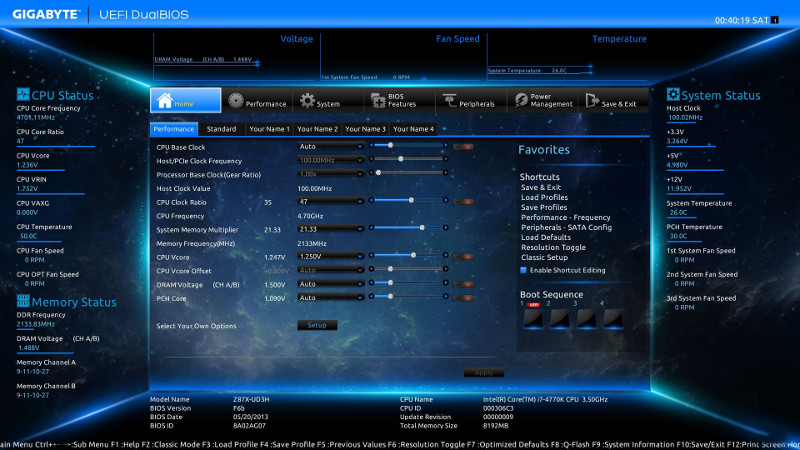
To check if your system is using UEFI boot, you can use following method.
Method 1: efibootmgr
On CentOS 7, efibootmgr is provided by package efibootmgr.
This server is using UEFI
[root@server ~]# efibootmgr BootCurrent: 0005 Timeout: 1 seconds BootOrder: 0000,0004,0005,0006,0007,0008,0009,0002 Boot0000* grub Boot0002 UEFI: Built-in EFI Shell Boot0004* UEFI: Intel(R) I350 Gigabit Network Connection Boot0005* UEFI: IP4 Intel(R) I350 Gigabit Network Connection Boot0006* UEFI: IP6 Intel(R) I350 Gigabit Network Connection Boot0007* UEFI: Intel(R) I350 Gigabit Network Connection Boot0008* UEFI: IP4 Intel(R) I350 Gigabit Network Connection Boot0009* UEFI: IP6 Intel(R) I350 Gigabit Network Connection [root@server ~]#
Here is a server that is not booted with UEFI
[root@server1 ~]# efibootmgr EFI variables are not supported on this system. [root@server1 ~]#
Method 2: dmesg
Here is a server booted using UEFI
[root@server ~]# dmesg | grep EFI [ 0.000000] efi: EFI v2.40 by American Megatrends [ 0.000000] ACPI: UEFI 00000000798a3080 000042 (v01 SUPERM SMCI--MB 01072009 00000000) [ 0.936744] fb0: EFI VGA frame buffer device [ 12.109532] EFI Variables Facility v0.08 2004-May-17 [root@server ~]#
Server not using UEFI boot
[root@server1 ~]# dmesg | grep EFI [ 0.000000] ACPI: UEFI 000000006dd52930 00042 (v01 00000000 00000000) [root@server1 ~]#
Method 3: Checking grub.cfg
Here is a server that use UEFI
[root@server ~]# cat /boot/grub2/grub.cfg | grep -i efi
if [ -s $prefix/grubenv ]; then
insmod efi_gop
insmod efi_uga
set locale_dir=$prefix/locale
if [ -f ${prefix}/user.cfg ]; then
source ${prefix}/user.cfg
linuxefi /boot/vmlinuz-3.10.0-693.2.2.el7.x86_64 root=UUID=908d7686-177e-42b8-856b-501445522a61 ro
initrdefi /boot/initramfs-3.10.0-693.2.2.el7.x86_64.img
linuxefi /boot/vmlinuz-3.10.0-693.2.2.el7.x86_64 root=UUID=908d7686-177e-42b8-856b-501445522a61 ro
initrdefi /boot/initramfs-3.10.0-693.2.2.el7.x86_64.img
linuxefi /boot/vmlinuz-3.10.0-693.2.2.el7.x86_64 root=UUID=908d7686-177e-42b8-856b-501445522a61 ro single
initrdefi /boot/initramfs-3.10.0-693.2.2.el7.x86_64.img
linuxefi /boot/vmlinuz-3.10.0-693.2.2.el7.x86_64.debug root=UUID=908d7686-177e-42b8-856b-501445522a61 ro
initrdefi /boot/initramfs-3.10.0-693.2.2.el7.x86_64.debug.img
linuxefi /boot/vmlinuz-3.10.0-693.2.2.el7.x86_64.debug root=UUID=908d7686-177e-42b8-856b-501445522a61 ro single
initrdefi /boot/initramfs-3.10.0-693.2.2.el7.x86_64.debug.img
linuxefi /boot/vmlinuz-0-rescue-1e98a4cc1263468b9f9a12e365316b95 root=UUID=908d7686-177e-42b8-856b-501445522a61 ro
initrdefi /boot/initramfs-0-rescue-1e98a4cc1263468b9f9a12e365316b95.img
linuxefi /boot/vmlinuz-0-rescue-1e98a4cc1263468b9f9a12e365316b95 root=UUID=908d7686-177e-42b8-856b-501445522a61 ro single
initrdefi /boot/initramfs-0-rescue-1e98a4cc1263468b9f9a12e365316b95.img
elif [ -z "${config_directory}" -a -f $prefix/custom.cfg ]; then
source $prefix/custom.cfg;
[root@server ~]#
Boot entry will be linuxefi, initrdefi instead of linux16/initrd16
Here is server that is booted with BIOS
[root@server1 ~]# cat /boot/grub2/grub.cfg | grep -i efi
if [ -s $prefix/grubenv ]; then
insmod efi_gop
insmod efi_uga
if [ -f ${prefix}/user.cfg ]; then
source ${prefix}/user.cfg
elif [ -z "${config_directory}" -a -f $prefix/custom.cfg ]; then
source $prefix/custom.cfg;
[root@server1 ~]#
Method 4: /boot/efi
Check for mount /boot/efi
[root@server ~]# df -h --local | grep /boot /dev/nvme0n1p1 510M 3.7M 507M 1% /boot/efi [root@server ~]#
If your server use BIOS, you won’t see /boot/efi

